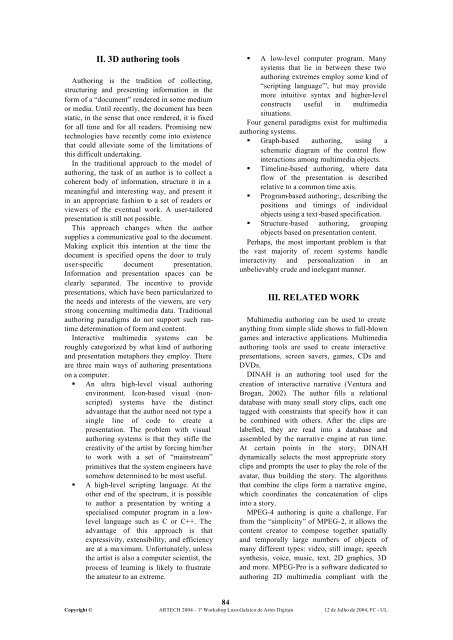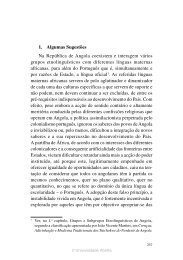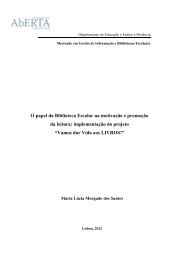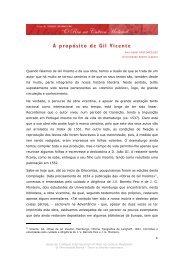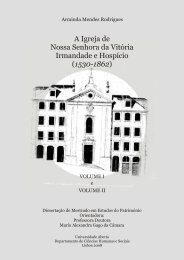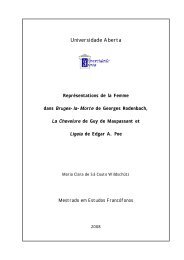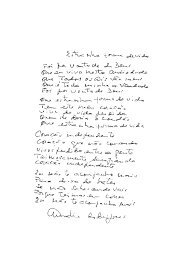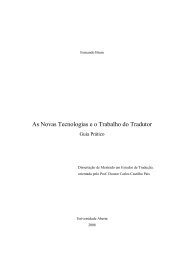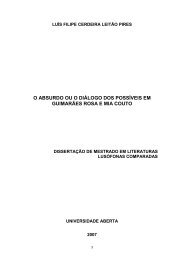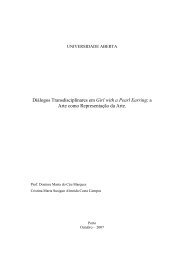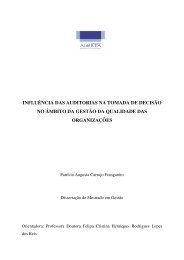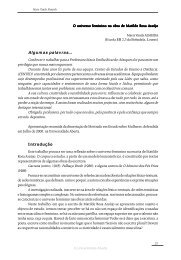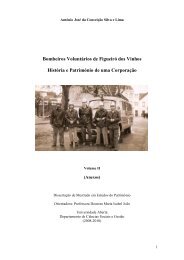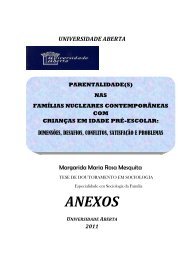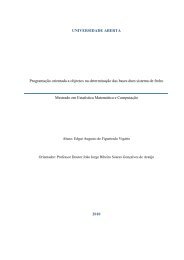NA SENDA DA IMAGEM A Representação ea Tecnologia na Arte
NA SENDA DA IMAGEM A Representação ea Tecnologia na Arte
NA SENDA DA IMAGEM A Representação ea Tecnologia na Arte
You also want an ePaper? Increase the reach of your titles
YUMPU automatically turns print PDFs into web optimized ePapers that Google loves.
II. 3D authoring tools<br />
Authoring is the tradition of collecting,<br />
structuring and presenting information in the<br />
form of a “document” rendered in some medium<br />
or media. Until recently, the document has been<br />
static, in the sense that once rendered, it is fixed<br />
for all time and for all r<strong>ea</strong>ders. Promising new<br />
technologies have recently come into existence<br />
that could alleviate some of the limitations of<br />
this difficult undertaking.<br />
In the traditio<strong>na</strong>l approach to the model of<br />
authoring, the task of an author is to collect a<br />
coherent body of information, structure it in a<br />
m<strong>ea</strong>ningful and interesting way, and present it<br />
in an appropriate fashion to a set of r<strong>ea</strong>ders or<br />
viewers of the eventual work. A user-tailored<br />
presentation is still not possible.<br />
This approach changes when the author<br />
supplies a communicative goal to the document.<br />
Making explicit this intention at the time the<br />
document is specified opens the door to truly<br />
user-specific document presentation.<br />
Information and presentation spaces can be<br />
cl<strong>ea</strong>rly separated. The incentive to provide<br />
presentations, which have been particularized to<br />
the needs and interests of the viewers, are very<br />
strong concerning multimedia data. Traditio<strong>na</strong>l<br />
authoring paradigms do not support such runtime<br />
determi<strong>na</strong>tion of form and content.<br />
Interactive multimedia systems can be<br />
roughly categorized by what kind of authoring<br />
and presentation metaphors they employ. There<br />
are three main ways of authoring presentations<br />
on a computer.<br />
An ultra high-level visual authoring<br />
environment. Icon-based visual (nonscripted)<br />
systems have the distinct<br />
advantage that the author need not type a<br />
single line of code to cr<strong>ea</strong>te a<br />
presentation. The problem with visual<br />
authoring systems is that they stifle the<br />
cr<strong>ea</strong>tivity of the artist by forcing him/her<br />
to work with a set of “mainstr<strong>ea</strong>m”<br />
primitives that the system engineers have<br />
somehow determined to be most useful.<br />
A high-level scripting language. At the<br />
other end of the spectrum, it is possible<br />
to author a presentation by writing a<br />
specialised computer program in a lowlevel<br />
language such as C or C++. The<br />
advantage of this approach is that<br />
expressivity, extensibility, and efficiency<br />
are at a ma ximum. Unfortu<strong>na</strong>tely, unless<br />
the artist is also a computer scientist, the<br />
process of l<strong>ea</strong>rning is likely to frustrate<br />
the amateur to an extreme.<br />
A low-level computer program. Many<br />
systems that lie in between these two<br />
authoring extremes employ some kind of<br />
“scripting language”', but may provide<br />
more intuitive syntax and higher-level<br />
constructs useful in multimedia<br />
situations.<br />
Four general paradigms exist for multimedia<br />
authoring systems.<br />
Graph-based authoring, using a<br />
schematic diagram of the control flow<br />
interactions among multimedia objects.<br />
Timeline-based authoring, where data<br />
flow of the presentation is described<br />
relative to a common time axis.<br />
Program-based authoring:, describing the<br />
positions and timings of individual<br />
objects using a text -based specification.<br />
Structure-based authoring, grouping<br />
objects based on presentation content.<br />
Perhaps, the most important problem is that<br />
the vast majority of recent systems handle<br />
interactivity and perso<strong>na</strong>lization in an<br />
unbelievably crude and inelegant manner.<br />
III. RELATED WORK<br />
Multimedia authoring can be used to cr<strong>ea</strong>te<br />
anything from simple slide shows to full-blown<br />
games and interactive applications. Multimedia<br />
authoring tools are used to cr<strong>ea</strong>te interactive<br />
presentations, screen savers, games, CDs and<br />
DVDs.<br />
DI<strong>NA</strong>H is an authoring tool used for the<br />
cr<strong>ea</strong>tion of interactive <strong>na</strong>rrative (Ventura and<br />
Brogan, 2002). The author fills a relatio<strong>na</strong>l<br />
database with many small story clips, <strong>ea</strong>ch one<br />
tagged with constraints that specify how it can<br />
be combined with others. After the clips are<br />
labelled, they are r<strong>ea</strong>d into a database and<br />
assembled by the <strong>na</strong>rrative engine at run time.<br />
At certain points in the story, DI<strong>NA</strong>H<br />
dy<strong>na</strong>mically selects the most appropriate story<br />
clips and prompts the user to play the role of the<br />
avatar, thus building the story. The algorithms<br />
that combine the clips form a <strong>na</strong>rrative engine,<br />
which coordi<strong>na</strong>tes the concate<strong>na</strong>tion of clips<br />
into a story.<br />
MPEG-4 authoring is quite a challenge. Far<br />
from the “simplicity” of MPEG-2, it allows the<br />
content cr<strong>ea</strong>tor to compose together spatially<br />
and temporally large numbers of objects of<br />
many different types: video, still image, speech<br />
synthesis, voice, music, text, 2D graphics, 3D<br />
and more. MPEG-Pro is a software dedicated to<br />
authoring 2D multimedia compliant with the<br />
84<br />
Copyright © ARTECH 2004 – 1º Workshop Luso-Galaico de <strong>Arte</strong>s Digitais 12 de Julho de 2004, FC - UL


